La Pampa Province
La Pampa (Spanish pronunciation: [la ˈpampa]) is a sparsely populated province of Argentina, located in the Pampas in the center of the country. Neighboring provinces are from the north clockwise San Luis, Córdoba, Buenos Aires, Río Negro, Neuquén and Mendoza.
La Pampa
Provincia de La Pampa | |
|---|---|
| Province of La Pampa | |
.jpg.webp) | |
 Flag 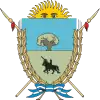 Coat of arms | |
.svg.png.webp) | |
| Coordinates: 36°37′S 64°17′W | |
| Country | Argentina |
| Capital | Santa Rosa |
| Divisions | 22 departments |
| Government | |
| • Governor | Sergio Ziliotto |
| • Senators | Daniel Lovera Norma Durango Juan Carlos Marino |
| Area | |
| • Total | 143,440 km2 (55,380 sq mi) |
| Population (2010[1]) | |
| • Total | 543,184 |
| • Rank | 22nd |
| • Density | 3.8/km2 (9.8/sq mi) |
| Demonym(s) | Pampeano |
| Time zone | UTC−3 (ART) |
| ISO 3166 code | AR-L |
| HDI (2018) | 0.838 Very High (5th)[2] |
| Website | www |
History
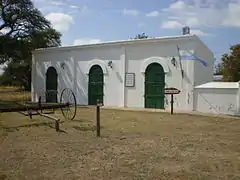
In 1604 Hernandarias was the first European explorer to reach the area; it was later explored by Jerónimo Luis de Cabrera in 1662. But it was not until the 18th century that Spanish colonists established permanent settlements here.
Resistance of the local indigenous people prevented much expansion until the government of Juan Manuel de Rosas. It did not cease until Julio Roca's conquest of the desert in the 19th century. The territory was divided between the officers, and they erected the first Spanish settlements.
The Territorio Nacional de La Pampa Central was erected in 1884, containing the Río Negro Province and parts of other surrounding provinces. It had around 25,000 inhabitants. By 1915 there were 110,000 residents, a reflection of movement to that area. In 1945 the territory was divided and La Pampa became a province.
In 1952 its constitution was written and the province was renamed after Eva Peron. In 1955 after the government changed and the Peróns went into exile, both La Pampa and Chaco, which had been named for Juan Perón, were reverted to their original names.
Geography

There are only two major rivers in the province: the Colorado ("Red River") on the border with the Province of Río Negro, and the Salado ("Salty River") crossing it. The Salado's level has been dropping, as its tributaries in the Province of Mendoza are diverted for irrigation.
The general aspect of the central-eastern part of the province is that of a plain gently tilted to the east that is dissected by valleys.[3] The surface of the plain has a calcrete crust. The valleys of La Pampa, known as the transverse valleys (Spanish: valles transversales) are NE-SW oriented, with breadths of various kilometers and lengths of tens of kilometers. Some of the valleys host very large fossil inland dunes.[3] Formerly functioning as windfunnels for sand[3] at present these valleys are an ecotone region between the Dry and Humid Pampas.[4]
While mostly flat the province do also contains mountains like Sierra de Lihuel Calel where a variety of landforms can be observed including inselbergs, flared slopes, domes, nubbins, tors, tafonis and gnammas.[5] Most of Sierra de Lihuel Calel is made up ignimbrite, a volcanic rock type that was violently erupted by ancient volcanoes.[5]
Climate
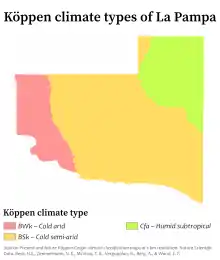
Being located in the Pampas, the province has a cool temperate climate.[6] In general, the province is dominated by two different types of climates: a temperate one in the east and a semi-arid one in the west.[7] Precipitation generally decreases from east to west and from north to south.[6][7] Being characterized by large thermal amplitudes, the climate of the province has continental characteristics, particularly in the west where thermal amplitudes are much larger.[6][7] The general atmospheric circulation is one of the most important factors that influence the climate on a regional scale.[8] During summer, the South Atlantic High is displaced to the southeast, which brings hot and humid air masses from the north and northeast.[8] The South Pacific High in summer is responsible for bringing cooler air masses from the southwest which when these two contrasting air masses meet lead to precipitation occurring.[8] In contrast, winters are dry due to the northward displacement of the South Atlantic high and the topographic barrier of the Andes north of 40oS which prevents frontal systems that bring precipitation from reaching the province.[8] Any winds from the southwest during winter bring in cold and dry weather since most of the precipitation and humidity are released in the Andes.[8] As such, most of the precipitation occurs during summer.[6]
Temperature
Mean annual temperatures in the province range between 14 to 16 °C (57.2 to 60.8 °F) although the thermal amplitude (difference between temperatures in the warmest and coldest months) is large.[6][8] In summer, mean temperatures in the warmest month (January) range from 24 °C (75.2 °F) in the north and northeastern parts to 22 °C (71.6 °F) in the west and southwestern parts of the province.[8] Temperatures tend to be cooler in the west owing to the higher altitudes.[8] In winter, mean temperatures in the coldest month (July) range from 8 °C (46.4 °F) in the north to 6 °C (42.8 °F) in the west and southwest.[8] The northern parts are the warmest parts of the province; absolute maximum temperatures can reach up to 40 to 45 °C (104.0 to 113.0 °F).[8] The lowest temperatures ever recorded range from −10 °C (14.0 °F) in the northeast to −17 °C (1.4 °F) in the southwest.[8]
Precipitation
One characteristic of the precipitation in the province is that most of the precipitation occurs from October to March with little precipitation during winter.[8] Mean annual precipitation ranges from a low of 260 mm (10 in) in the southwest to 820 mm (32 in) in the northeast.[6] Precipitation generally decreases from northeast to southwest.[6] Most of the precipitation is caused by frontal systems.[8] Precipitation is highly variable from year to year.[8]
Economy
La Pampa, long Argentina's most economically agricultural province, produced an estimated US$3.144 billion in output in 2006, or, US$10,504 per capita (almost 20% above the national average).[9] Now, the GDP per capita of the province is of US$14.000.
Agriculture contributes a fourth to La Pampa's economy, the most important activity being cattle ranching, with 3,632,684 (2002) head, which takes place all over the province. Other livestock include 202,428 sheep, 140,498 goats and 64,118 pigs.
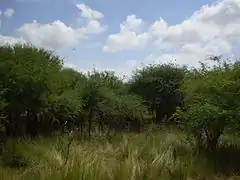
The Northeast, on the more fertile lands, has also an important activity with wheat (10% of the national production), sunflower (13% of NP), maize, alfalfa, barley, and other cereals.
There's also a dairy industry of 300 centres of extraction and 25 cheese factories, honey production, and salt extraction from salt basins.
La Pampa is home to very little industry, construction or mining and, so, its services sector accounts for over two-thirds of the economy, a fairly high proportion. Tourism is an underdeveloped activity, however. Visitors start at Santa Rosa and reach Lihué Calel National Park, Parque Luro Provincial Reserve or visit one of the many estancias, some of which are dedicated to agritourism.
Government
The provincial government is divided into the usual three branches: the executive, headed by a popularly elected governor, who appoints the cabinet; the legislative; and the judiciary, headed by the Supreme Court.
The Constitution of La Pampa Province forms the formal law of the province.
In Argentina, the most important law enforcement organization is the Argentine Federal Police but the additional work is carried out by the La Pampa Provincial Police.
Political divisions

The province is divided in 22 departments (Spanish: departamentos).
Department (Capital)
- Atreuco Department (Macachín)
- Caleu Caleu Department (La Adela)
- Capital (Santa Rosa)
- Catriló Department (Catriló)
- Chalileo Department (Santa Isabel)
- Chapaleufú Department (Intendente Alvear)
- Chical Có Department (Algarrobo del Aguila)
- Conhelo Department (Eduardo Castex)
- Curacó Department (Puelches)
- Guatraché Department (Guatraché)
- Hucal Department (Bernasconi)
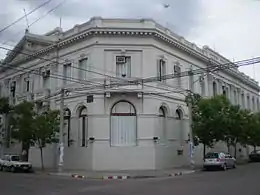 Supreme Court of La Pampa.
Supreme Court of La Pampa. - Lihuel Calel Department (Cuchillo-Có)
- Limay Mahuida Department (Limay Mahuida)
- Loventué Department (Victorica)
- Maracó Department (General Pico)
- Puelén Department (Veinticinco de Mayo)
- Quemú Quemú Department (Quemú Quemú)
- Rancul Department (Parera)
- Realicó Department (Realicó)
- Toay Department (Toay)
- Trenel Department (Trenel)
- Utracán Department (General Acha)
References
- "Censo 2010 Argentina resultados definitivos: mapas". 200.51.91.231. Archived from the original on 2012-09-01. Retrieved 2012-08-15.
- "Información para el desarrollo sostenible: Argentina y la Agenda 2030" (PDF) (in Spanish). United Nations Development Programme. p. 155. Archived from the original (PDF) on 25 August 2017. Retrieved 25 August 2017.
- Tripaldi, Alfonsina; Mejl, Adriana; Zárate, Marcelo A. (2018). "Parabolic megadunes in a subtropical Quaternary inland dune field, southwestern Pampas, Argentina". Geomorphology. 321: 103–116. doi:10.1016/j.geomorph.2018.08.021.
- Berón, Mónica; Carrera Aizpitarte, Manuel; Páez, Florencia (2015). "Arqueología en el área de Valles Transversales (provincia de La Pampa, Argentina)" [Archaeology in the Valles Transversales area (Province of La Pampa, Argentina). Characteristics and trends of archaeological record. Social implications in the construction of landscape]. Relaciones de la Sociedad Argentina de Antropología (in Spanish). XL (2): 549–587.
- Aguilera, Emilia Y.; Sato, Ana María; Llambías, Eduardo; Tickyj, Hugo (2014). "Erosion Surface and Granitic Morphology in the Sierra de Lihuel Calel, Province of La Pampa, Argentina". In Rabassa, Jorge; Ollier, Cliff (eds.). Gondwana Landscapes in southern South America. Springer. pp. 393–422.
- "Provincia de La Pampa–Clima Y Metéorologia" (in Spanish). Secretaria de Mineria de la Nacion (Argentina). Archived from the original on May 15, 2009. Retrieved June 9, 2017.
- "Clima de La Pampa" (in Spanish). Gobierno de La Pampa. Archived from the original on June 9, 2017. Retrieved June 9, 2017.
- "Caracterización General de la provincial" (PDF). INVENTARIO INTEGRADO DE LOS RECURSOS NATURALES DE LA PROVINCIA DE LA PAMPA: Clima, Geomorfología, Suelo y Vegetación (in Spanish). Instituto Nacional de Tecnología Agropecuaria. 2004. pp. 19–32. Archived from the original (PDF) on June 10, 2017. Retrieved June 10, 2017.
- "El déficit consolidado de las provincias rondará los $11.500 millones este año" (in Spanish). Instituto Argentino para el Desarrollo de las Economías Regionales. Retrieved 10 July 2015.
External links
| Wikimedia Commons has media related to La Pampa Province. |
- Official (government) Website (Spanish)
- Provincial Tourist Office (Spanish)
- Universidad Nacional de La Pampa (Spanish)
- REGION Guide to La Pampa (Spanish/English)
- Map of La Pampa and its Departamentos (out of date)